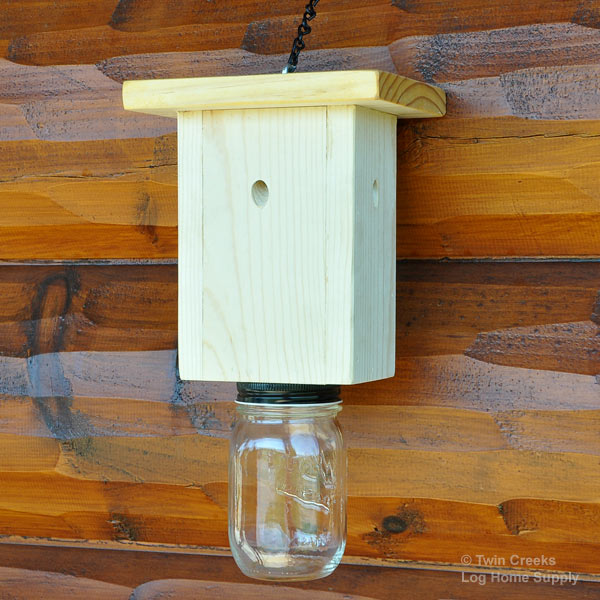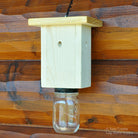Brilliantly designed, our Carpenter Bee Traps are the perfect solution to the damage being done to your home by carpenter bees. Easily affixed to any structure, the trap consists of a small wooden box, pre-drilled with angled holes around the perimeter, and a port to attach a 16-ounce glass Mason jar at the bottom.
How Does It Work?
Once installed, carpenter bees are lured into the box in one of two ways. First, a bee will enter the angled holes to avoid drilling a new hole in which to build its nest. Second, once a bee is inside the trap, it emits a signal that draws other carpenter bees to its vicinity.
Once inside, the bees fall through the wooden trap down to the glass jar. Carpenter bees cannot escape back out of the trap because the opening at the bottom of the jar is smaller than the diameter of their wings.
When the Mason jar becomes full, it can simply be unscrewed and emptied.
Design Benefits:
• The trap is made with rounded edges to easily shed water.
• Each trap comes with a port to attach a 16-ounce Mason jar. Mason jars are not included.
• Every trap has a sizable overhang to keep water off the trap and out of the pre-drilled holes.
• Each trap is made from high-quality Spruce or Pine.
• The Small size trap hangs from a chain and comes pre-drilled with 3 holes.
• Our Carpenter Bee Traps are proudly made in East Tennessee.
Instructions:
• Hang the trap in the area of highest bee activity.• Plug any existing holes on the house or structure, so that the carpenter bees will seek out holes in the trap rather than bore a new hole.
• When the jar is full, simply unscrew and empty it. It is recommended that you leave one female bee (black head) in the trap, as the pheromone released by the female bee will attract male bees.
• If you wish to use your trap to attract hornets, wasps, and yellow jackets in addition to carpenter bees, add 1 inch of sugared soda such as Mountain Dew and 5 drops of dish soap to the inside of the jar.
Product Questions
-
Will a bumble bee go in to a carpenter bee trap?
Bumble bees can go into the carpenter bee trap's holes, but they're not likely to do so. Carpenter bees burrow into wood to build a nest. They look for already drilled holes in wood so they don't have to build a new tunnel for nesting. The 1/2" diameter holes in the carpenter bee trap are the same size as a carpenter bee hole, so they offer an attractive lure to the carpenter bees. Bumble bees live in colonies and in nests built in the ground, so the hole in the carpenter bee trap isn't appealing to them. Additionally, bumble bees are slightly smaller than carpenter bees, so if one were to enter the trap, it could exit the trap more easily than the carpenter bee.
-
Is the wood on the trap raw or treated? Will the trap attract more bees if it is left in a contrasting color to the log siding, or can it be stained to match the log siding? Thanks for your help.
The wood that is used to build our carpenter bee traps is left unfinished and actually, the color of the wood isn't what is attractive to the bees. Carpenter bees are attracted to unfinished softwoods, like the pine and spruce used to build our traps. You certainly can stain or paint the carpenter bee trap to match the siding, but we believe you will catch more carpenter bees if it is left unfinished. For more information on carpenter bees please read The Log Homes Council "Controlling Carpenter Bees" Tech Note, https://www.twincreeksloghomes.com/images/Pdf/log-tech-note-02-01-controlling-carpenter-bees.pdf
-
Are carpenter bees and borer bees different from one another?
No, they are the same species of bee. Carpenter bee is one of the most common names, but other names can include borer bee or wood boring bee. For more information on Carpenter Bees please visit: https://www.permachink.com/blog/carpenter-bees.
DETAILS
Brilliantly designed, our Carpenter Bee Traps are the perfect solution to the damage being done to your home by carpenter bees. Easily affixed to any structure, the trap consists of a small wooden box, pre-drilled with angled holes around the perimeter, and a port to attach a 16-ounce glass Mason jar at the bottom.
How Does It Work?
Once installed, carpenter bees are lured into the box in one of two ways. First, a bee will enter the angled holes to avoid drilling a new hole in which to build its nest. Second, once a bee is inside the trap, it emits a signal that draws other carpenter bees to its vicinity.
Once inside, the bees fall through the wooden trap down to the glass jar. Carpenter bees cannot escape back out of the trap because the opening at the bottom of the jar is smaller than the diameter of their wings.
When the Mason jar becomes full, it can simply be unscrewed and emptied.
Design Benefits:
• The trap is made with rounded edges to easily shed water.
• Each trap comes with a port to attach a 16-ounce Mason jar. Mason jars are not included.
• Every trap has a sizable overhang to keep water off the trap and out of the pre-drilled holes.
• Each trap is made from high-quality Spruce or Pine.
• The Small size trap hangs from a chain and comes pre-drilled with 3 holes.
• Our Carpenter Bee Traps are proudly made in East Tennessee.
Instructions:
• Hang the trap in the area of highest bee activity.• Plug any existing holes on the house or structure, so that the carpenter bees will seek out holes in the trap rather than bore a new hole.
• When the jar is full, simply unscrew and empty it. It is recommended that you leave one female bee (black head) in the trap, as the pheromone released by the female bee will attract male bees.
• If you wish to use your trap to attract hornets, wasps, and yellow jackets in addition to carpenter bees, add 1 inch of sugared soda such as Mountain Dew and 5 drops of dish soap to the inside of the jar.
REVIEWS
PRODUCT QUESTIONS
Product Questions
-
Will a bumble bee go in to a carpenter bee trap?
Bumble bees can go into the carpenter bee trap's holes, but they're not likely to do so. Carpenter bees burrow into wood to build a nest. They look for already drilled holes in wood so they don't have to build a new tunnel for nesting. The 1/2" diameter holes in the carpenter bee trap are the same size as a carpenter bee hole, so they offer an attractive lure to the carpenter bees. Bumble bees live in colonies and in nests built in the ground, so the hole in the carpenter bee trap isn't appealing to them. Additionally, bumble bees are slightly smaller than carpenter bees, so if one were to enter the trap, it could exit the trap more easily than the carpenter bee.
-
Is the wood on the trap raw or treated? Will the trap attract more bees if it is left in a contrasting color to the log siding, or can it be stained to match the log siding? Thanks for your help.
The wood that is used to build our carpenter bee traps is left unfinished and actually, the color of the wood isn't what is attractive to the bees. Carpenter bees are attracted to unfinished softwoods, like the pine and spruce used to build our traps. You certainly can stain or paint the carpenter bee trap to match the siding, but we believe you will catch more carpenter bees if it is left unfinished. For more information on carpenter bees please read The Log Homes Council "Controlling Carpenter Bees" Tech Note, https://www.twincreeksloghomes.com/images/Pdf/log-tech-note-02-01-controlling-carpenter-bees.pdf
-
Are carpenter bees and borer bees different from one another?
No, they are the same species of bee. Carpenter bee is one of the most common names, but other names can include borer bee or wood boring bee. For more information on Carpenter Bees please visit: https://www.permachink.com/blog/carpenter-bees.




